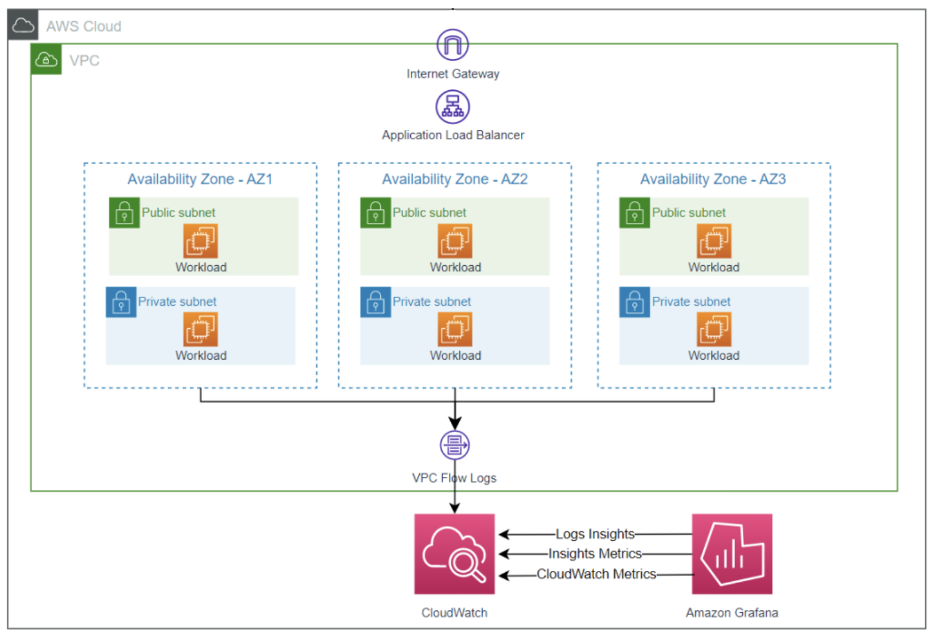VPC Flow Logs for Network Observability
In modern cloud environments, network observability plays a crucial role in ensuring the security, performance, and reliability of your applications and infrastructure. Amazon Virtual Private Cloud (VPC) Flow Logs, a feature provided by Amazon Web Services (AWS), offers a powerful tool for gaining visibility into network traffic within your VPCs, enabling effective troubleshooting and security analysis.
VPC Flow Logs capture metadata about the IP traffic flowing in and out of your VPC, providing valuable insights into network communication patterns, potential security threats, and performance bottlenecks. By leveraging VPC Flow Logs, organizations can achieve the following benefits:
-
Network Traffic Visibility: VPC Flow Logs record detailed information about network traffic, including source and destination IP addresses, ports, protocols, packet sizes, and flow directions. This comprehensive visibility into network traffic patterns enables organizations to identify anomalies, detect potential security threats, and optimize network configurations.
-
Security Monitoring and Threat Detection: By analyzing VPC Flow Logs, security teams can monitor network traffic for suspicious activities, such as unauthorized access attempts, port scanning, or data exfiltration attempts. This proactive monitoring approach helps organizations detect and respond to potential security threats more effectively.
-
Compliance and Auditing: VPC Flow Logs provide a detailed audit trail of network traffic, enabling organizations to meet compliance requirements and demonstrate adherence to security policies and industry regulations. This audit trail can also aid in forensic investigations and incident response efforts.
-
Application Performance Troubleshooting: Network bottlenecks or connectivity issues can significantly impact application performance. VPC Flow Logs allow organizations to identify and troubleshoot network-related performance issues by analyzing traffic patterns, identifying potential bottlenecks, and optimizing network configurations accordingly.
-
Cost Optimization: By analyzing VPC Flow Logs, organizations can gain insights into network traffic patterns and resource utilization. This information can be used to optimize network configurations, rightsizing network resources, and potentially reducing unnecessary costs associated with over-provisioning or underutilized resources.
 Figure 1: VPC flow logs visualization with Grafana
Figure 1: VPC flow logs visualization with Grafana
To leverage VPC Flow Logs for network observability and troubleshooting, organizations can follow these general steps:
-
Enable VPC Flow Logs: Configure VPC Flow Logs for your VPCs or specific network interfaces within your VPCs, specifying the desired log destination (e.g., Amazon CloudWatch Logs, Amazon S3, or a third-party log management solution).
-
Analyze Log Data: Utilize log analysis tools or custom scripts to parse and analyze the VPC Flow Log data, identifying patterns, anomalies, or potential security threats based on the recorded network traffic information.
-
Integrate with Security and Monitoring Tools: Incorporate VPC Flow Log data into your existing security and monitoring solutions, such as Security Information and Event Management (SIEM) systems, to correlate network traffic data with other security events and alerts.
-
Set Up Alerts and Notifications: Configure alerts and notifications based on specific patterns or thresholds detected in VPC Flow Logs, enabling proactive response to potential security threats or performance issues.
-
Optimize Network Configurations: Leverage insights from VPC Flow Logs to optimize network configurations, fine-tune security group rules, and implement traffic shaping or filtering mechanisms to enhance network performance and security posture.
While VPC Flow Logs provide valuable network observability and troubleshooting capabilities, it's important to consider potential challenges such as log data volume and cost management. As the volume of network traffic increases, the amount of log data generated can grow significantly, potentially impacting storage costs and performance. Implementing log data retention policies, sampling strategies, and cost optimization techniques may be necessary to ensure an efficient and cost-effective logging solution.
Additionally, ensuring proper access control and data security for your VPC Flow Logs is crucial. AWS provides granular access control mechanisms and encryption capabilities to protect the confidentiality and integrity of your log data.
In conclusion, VPC Flow Logs are a powerful tool for achieving network observability and enabling effective troubleshooting in AWS environments. By providing detailed insights into network traffic patterns, VPC Flow Logs empower organizations to monitor security threats, optimize network configurations, troubleshoot performance issues, and maintain compliance. With the integration of VPC Flow Logs into existing security and monitoring solutions, organizations can enhance their overall observability and maintain a secure, high-performing, and reliable cloud infrastructure.